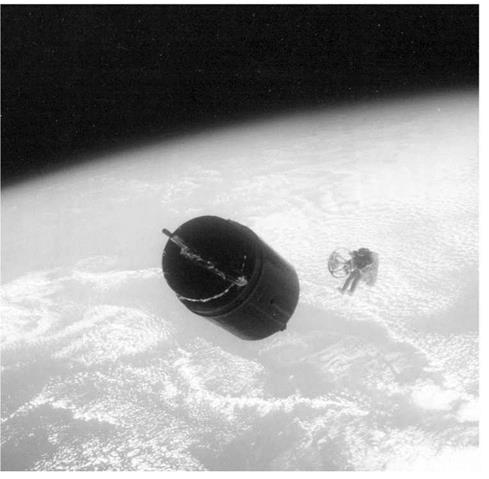STS 51-A
|
Int. Designation |
1984-113A |
|
Launched |
8 November 1984 |
|
Launch Site |
Pad 39A, Kennedy Space Center, Florida |
|
Landed |
16 November 1984 |
|
Landing Site |
Runway 15 North, Kennedy Space Center, Florida |
|
Launch Vehicle |
OV-103 Discovery/ET-16/SRB A65; A66/SSME #1 2109; |
|
#2 2018; #3 2012 |
|
|
Duration |
7 days 23 hrs 44 min 56 sec |
|
Callsign |
Discovery |
|
Objective |
Satellite deployment and retrieval mission |
Flight Crew
HAUCK, Frederick Hamilton “Rick”, 43, USN, commander, 2nd mission Previous mission: STS-7 (1983)
WALKER, David Mathieson, 40, USN, pilot
ALLEN, Joseph Percival, 47, civilian, mission specialist 1, 2nd mission Previous mission: STS-5 (1982)
FISHER, Anna Lee Tingle, 35, civilian, mission specialist 2 GARDNER, Dale Allan, 36, USN, mission specialist 3, 2nd mission Previous mission: STS-8 (1983)
Flight Log
The loss of the Westar and Palapa communications satellites in useless orbits during the Shuttle STS 41-B mission was unkindly blamed on the Shuttle, which had an opportunity to make spectacular amends the following November. Lloyds of London had paid out about $270 million for the loss of the satellites, and in the hope of recouping some of that loss it invested a further $15 million to mount the most ambitious Shuttle mission yet: to retrieve the satellites, return them to Earth, refurbish them, re-sell them and re-launch them into orbit, generating perhaps $90 million and reducing the overall insurance loss.
STS 51-A was to have been just a routine deployment mission for its five crew, including Joe Allen (EV1) and Dale Gardner (EV2), who as the EVA crewmen devised the rescue plan with satellite contractors. Discovery’s take-off was delayed by a day when the count was stopped due to high winds at altitude, but all went well the following day at 07:15 hrs local time when STS 51-A ascended into clear blue skies, treating observers to a fine view of SRB separation. The Anik and Leasat communications satellites were routinely deployed on the second and third days, and eventually found themselves on station in geostationary orbit.
|
Joe Allen retrieves the Palapa satellite using the MMU and the “stinger” device |
On 12 November, Discovery made a rendezvous to within 10 m (33 ft) of the first stranded satellite, Palapa, which had been nudged into a lower orbit by remote control to facilitate the rescue. The Shuttle performed a record 16 manoeuvres for the rendezvous in the 28° orbit, which reached a maximum altitude of 312 km (194 miles). Joe Allen, floating inside his spacesuit, propelled himself across to Palapa using an MMU, and with the aid of a docking rod called a “stinger” joined up with the satellite’s apogee motor nozzle. Allen and his catch were themselves then snared by RMS, deftly operated by Anna Fisher. Meanwhile, inside the payload bay, Gardner cut away at the satellite’s antenna to ensure that it could fit inside the payload bay in a special frame. The frame didn’t work, however, and Allen had to hold the 544 kg (1,200 lb) satellite steady over his head for 77 minutes while Gardner fixed a contingency adapter. The procedure worked so well that it was decided that when
Gardner rescued Westar the following day, the same method would be used again, with Allen again playing Charles Atlas.
The two EVAs lasted 6 hours 13 minutes and 6 hours 1 minutes, with Allen and Gardner clocking up 2 hours 22 minutes and 1 hour 40 minutes MMU flying time. It had been a brilliant demonstration of human abilities in space and the unique capability of the Shuttle system. Discovery came home to runway 15 at the KSC, at T + 7 days 23 hours 44 minutes 56 seconds and the crew later received the Lloyds Silver Medal for the first salvage in space. After much effort, Lloyds managed to dispose of the refurbished satellites. Westar became Asiasat and was scheduled to be launched by a Chinese Long March 3 in 1990. Palapa was re-sold to Indonesia and was also launched in 1990, by a Delta 2 from Cape Canaveral.
Milestones
102nd manned space flight 45th US manned space flight 14th Shuttle mission 2nd flight of Discovery
1st retrieval of satellites and their return to Earth 20th US and 29th flight with EVA operations
Gardner celebrates his 36th birthday with the launch of STS 51-A (8 November)











